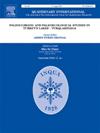马尔马拉地区古气候与植被动态(14000 - 5000 cal BP)
IF 1.8
3区 地球科学
Q3 GEOGRAPHY, PHYSICAL
引用次数: 0
摘要
本文研究了晚更新世和全新世早期马尔马拉地区和巴尔干部分地区过去的气候和植被动态。它侧重于环境随时间的变化,特别是从草原到林地的转变以及随后的森林砍伐过程。该研究综合了14000 - 5000 cal BP的考古、孢粉学和气候数据,重建了生态模式,并探讨了它们对景观演变的影响。为了加强对气候和植被变化的认识,本研究采用了模型输出和经验数据相结合的方法。具体来说,CHELSA数据集的降水和温度数据与使用15个气象站观测校准的宏观物理气候模式的输出进行了比较。这种方法是通过广泛的文献回顾来补充的,包括花粉记录、气候数据和时间顺序分析。通过综合这些证据,本研究提供了该地区晚更新世和全新世早期的古环境条件的可靠重建。花粉记录和气候重建表明,这一时期的环境条件由开阔的草原向密集的林地转变。这些变化反映了更广泛的气候变化,包括变暖趋势和降水变化,这些变化影响了植被组成和分布。综合这些资料揭示了全新世初期的重大生态转变。最初以草地为主,随着气候条件变暖并变得更加稳定,景观逐渐转向林地生态系统。当代气候模式的逐渐建立反映在花粉记录中观测到的植被动态中。随附的分析详细说明,这种转变突出了马尔马拉地区生态系统对气候波动的敏感性,并突出了气候演变与植被发展之间的复杂关系。通过分析马尔马拉南部和东部以及巴尔干半岛的微区域数据,本文强调了这些转变的时空变异性。马尔马拉地区位于地中海和黑海之间,是一个重要的生态和迁徙走廊。它的地理和气候环境为研究植被对气候波动的反应提供了一个独特的案例。这项研究有助于对过去气候环境动态及其在形成区域景观中的作用进行更广泛的讨论。本文章由计算机程序翻译,如有差异,请以英文原文为准。
Paleoclimate and vegetation dynamics in the Marmara region (14,000–5,000 cal BP)
This paper examines past climate and vegetation dynamics in the Marmara Region and parts of the Balkans during the Late Pleistocene and Early Holocene. It focuses on environmental transitions over time, particularly the shift from grasslands to woodlands and subsequent processes of deforestation. The study integrates archaeological, palynological, and climatic data spanning from 14,000 to 5000 cal BP to reconstruct ecological patterns and explore their implications for landscape evolution.
To enhance the understanding of climatic and vegetation changes, this study employs a combination of model outputs and empirical data. Specifically, precipitation and temperature data from the CHELSA dataset are compared against the outputs of a Macrophysical Climate Model calibrated using observations from 15 meteorological stations. This approach is supplemented by an extensive review of the literature, incorporating pollen records, climate data, and chronological analyses. By integrating these multiple lines of evidence, the study provides a robust reconstruction of the region's paleoenvironmental conditions during the Late Pleistocene and Early Holocene.
Pollen records and climate reconstructions indicate that environmental conditions transitioned from open grasslands to denser woodlands during this period. These shifts reflect broader climatic changes, including warming trends and variations in precipitation, which influenced vegetation composition and distribution. The synthesis of these data reveals a significant ecological transformation at the beginning of the Holocene. Initially dominated by grassland formations, the landscape progressively shifted towards woodland ecosystems as climatic conditions warmed and became more stable. The gradual establishment of contemporary climate patterns is reflected in the vegetation dynamics observed in the pollen records. As detailed in the accompanying analysis, this transition underscores the sensitivity of the Marmara Region's ecosystems to climatic fluctuations and highlights the intricate relationship between climate evolution and vegetation development.
By analyzing microregional data from southern and eastern Marmara and the Balkans, this paper highlights the spatial and temporal variability of these transitions. The Marmara Region, situated between the Mediterranean and Black Seas, serves as a crucial ecological and migratory corridor. Its geographic and climatic setting provides a unique case for examining vegetation responses to climate fluctuations. This study contributes to broader discussions on past climate–environment dynamics and their role in shaping regional landscapes.
求助全文
通过发布文献求助,成功后即可免费获取论文全文。
去求助
来源期刊

Quaternary International
地学-地球科学综合
CiteScore
5.60
自引率
4.50%
发文量
336
审稿时长
3 months
期刊介绍:
Quaternary International is the official journal of the International Union for Quaternary Research. The objectives are to publish a high quality scientific journal under the auspices of the premier Quaternary association that reflects the interdisciplinary nature of INQUA and records recent advances in Quaternary science that appeal to a wide audience.
This series will encompass all the full spectrum of the physical and natural sciences that are commonly employed in solving Quaternary problems. The policy is to publish peer refereed collected research papers from symposia, workshops and meetings sponsored by INQUA. In addition, other organizations may request publication of their collected works pertaining to the Quaternary.
 求助内容:
求助内容: 应助结果提醒方式:
应助结果提醒方式:


